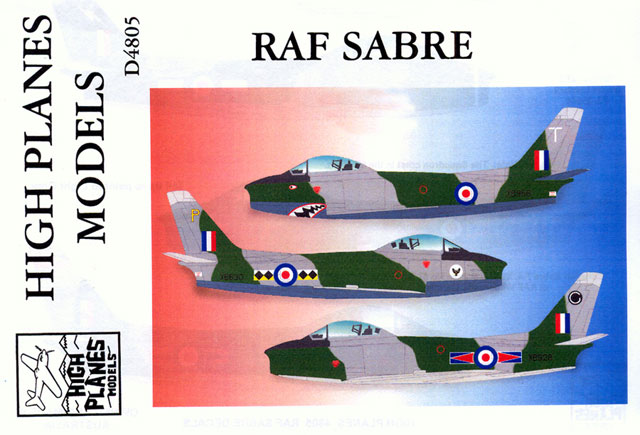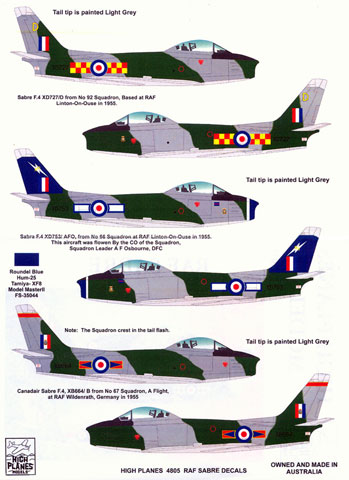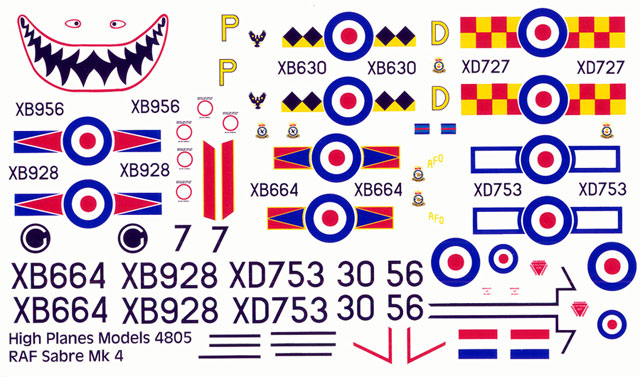|
Royal Air Force Sabres

High Planes Models, 1/48 scale
S u m m a r y
|
| Catalogue
Number and Description: |
D4805 Royal Air Force
Sabres |
| Scale: |
1/48 |
| Contents and Media: |
Decal sheet;
detailed colour placement instructions and historical notes. |
| Price: |
AUD$15.00 (approx USD$11.37) from High Planes Models' website |
| Review Type: |
FirstLook |
| Advantages: |
Interesting subjects;
available kit; good quality instructions including historical notes; well printed;
six subjects on sheet |
| Disadvantages: |
|
| Recommendation: |
Recommended |
Reviewed by Rodger Kelly

HyperScale is proudly sponsored by
Squadron
High Planes Models is an Australian company
based in Corryong, a country town in the state of Victoria. They
have been around for quite a few years now and specialize in
limited-run kits and conversions. Lately, they have ventured into
the decal world and, as with their kits, the decal sheets they
produce feature markings that are not produced by the main-stream
decal companies.
Sheet 4805 is a case in point. It features
markings for six Royal Air Force (RAF) Canadian Sabre F4s. The
individual machines and their markings are:
 XD727
of 92 Squadron based at RAF (Station) Linton-On-Ouse in 1958.
Camouflage finish is dark green and dark sea grey upper surfaces
over (painted) aluminum undersurfaces. Supplied markings comprise: XD727
of 92 Squadron based at RAF (Station) Linton-On-Ouse in 1958.
Camouflage finish is dark green and dark sea grey upper surfaces
over (painted) aluminum undersurfaces. Supplied markings comprise:
- Red and yellow chequerboard squadron
markings for the fuselage that includes the type D roundel (as
do all of the squadron markings on this sheet)
- Yellow letter D individual aircraft code
for the vertical stabilizer
- Black XD727 serial for the rear fuselage.
XD753 of 66 Squadron (The Commanding Officer's
aircraft) at RAF Linton-On-Ouse in 1955. Camouflage finish is dark
green and dark sea grey upper surfaces over aluminum undersurfaces
with a roundel blue vertical stabilizer and roundel blue and white
nose. Supplied markings comprise:
- Blue and white squadron markings for the
fuselage
- A white lighting bolt with the letters AFO
in yellow for the vertical stabilizer
- Squadron crests for both sides of the nose
- Squadron Leaders pennants for both sides
of the fuselage
- Black XD753 serial for the rear fuselage.
XB664 of A Flight, 67 Squadron, Wildenrath,
Germany in 1955. Camouflage finish is dark green and dark sea grey
upper surfaces over aluminum undersurfaces. The supplied markings
comprise:
- Red and blue, with thin yellow outlined
squadron markings for the fuselage
- Squadron crests, which are applied over
the white portion of the fin flash.
- A red band with a thin yellow outline for
the top of the vertical stabilizer
- Black XB664 serial for the rear fuselage
XB630 of 71 Squadron, also at Wildenrath,
Germany in 1955. Camouflage finish is dark green and dark sea grey
upper surfaces over PRU undersurfaces. The supplied markings
comprise:
- Black, white and yellow squadron markings
for the fuselage
- 72 Squadron eagle insignia on a white
circle background for both sides of the nose
- Yellow letter P for the top of the
vertical stabilizer
- Black XB630 for the rear fuselage
XB956 of 112 Squadron at Bruggen, Germany in
1956. Camouflage finish is dark green and dark sea grey upper
surfaces over PRU undersurfaces. The supplied markings comprise:
- 112 Squadron's famous shark mouth marking
for the nose – a one-piece decal.
- A pair of "eyes" for the nose
- A white letter T for the top of the
vertical stabilizer
- Black XB956 serial for the fuselage
The final option is XB928 of 130 Squadron in
the mid 1950s. Camouflage finish is dark green and dark sea grey
upper surfaces over aluminum undersurfaces. The supplied markings
comprise:
- Red and blue with thin white outlined
squadron markings for the fuselage
- White letter G on a black circle
background for the top of the vertical stabilizer
- Black XB928 serial for the rear fuselage
Large black serials are also supplied for the
lower surfaces of the wings. These are a bit of a mish-mash.
Complete serials (two of each) are supplied for under wing for
XB664, XB928 and XD753. However, you will have to use your scalpel
to modify these serials, plus use the extra 30, 56 supplied to
complete the serial for the remaining three options.

A single set of upper and lower wing roundels
are supplied as is a single fin flash. Stencil data is limited to
the larger items and includes, ejection seat triangles, wing walk
outlines, beware of exhaust warnings, fuel filler points, no-step
outlines for the wing flaps and a set of black stripes for the lower
rear fuselage (trestles markings?).
The placement guide is A-4 in size and shows
both left and right hand side full colour profiles of each subject
as well as an upper and lower surface plan view of the dark green
and dark sea grey over aluminum undersurface and a single lower
surface PRU plan view. The placement guide gives the British
Standard numbers for each camouflage colour and matches these to
both Humbrol and Model Master paints. Tamiya paints also get a
mention as a match to Roundel Blue.
The decals themselves have been printed in
Australia. The printer is not identified but they look every bit as
good as Microscale decals. They are sharply printed and in perfect
register.
The placement guides – there are two sheets –
and the decals come packed in a clear plastic zip-loc bag.
A nice sheet. If you want to add something
different to your F-86 collection then this is the sheet for you.
Nice one Meggsy!
Recommended.
Footnote:
What was a Sabre Mk 4 and can you model
one from either the Haseagwa or Academy kits? Yes you can. In
fact, High Planes Models have re-packaged the Academy kit along with
this sheet as an all-in-one package. Go to their website and see
for yourself
http://www.corryongcec.net.au/~hiplanes/4805.htm
If you want to know even more about the Mk 4
Sabre and what wing was fitted to it, go to the IPMS Canada website
where there is a thread on the subject
http://www.ipmscanada.com/threads/th10-RCAF%20Sabre%204.html
Review Copyright © 2004 by
Rodger Kelly
This Page Created on 08 November, 2004
Last updated
08 November, 2004
Back to
HyperScale Main Page Back to Reviews Page |
Home | What's
New | Features
| Gallery |
Reviews | Reference
| Forum
| Search